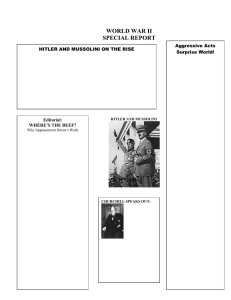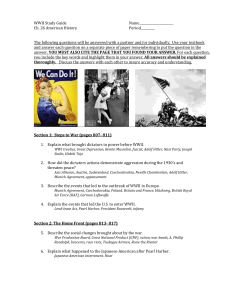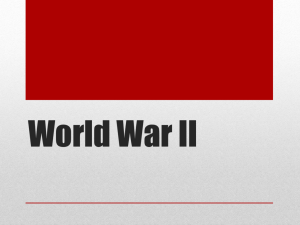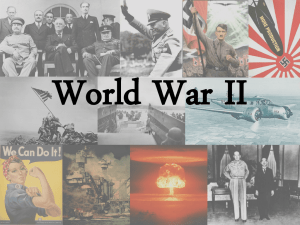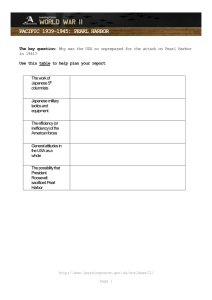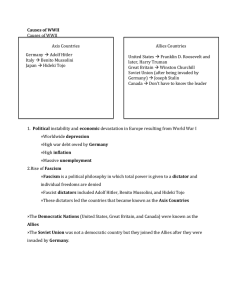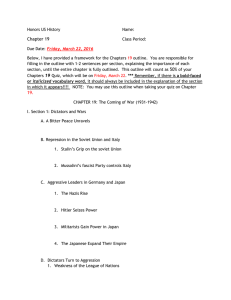World War II 1 U.S. II 7 a, b, c
advertisement
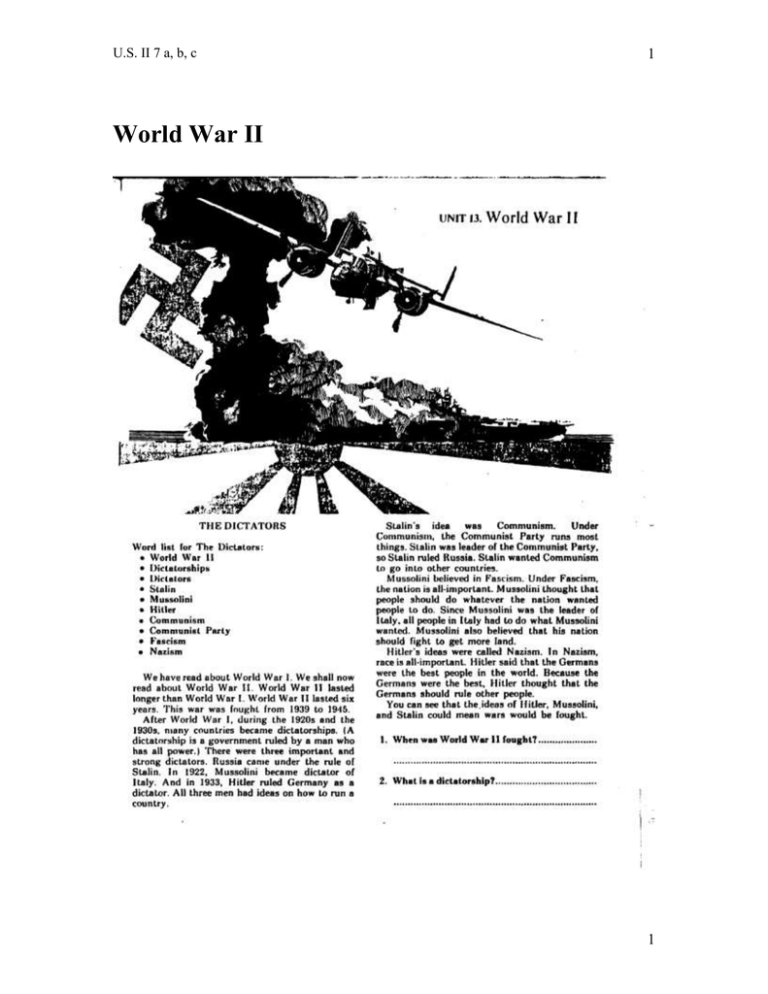
U.S. II 7 a, b, c 1 World War II 1 U.S. II 7 a, b, c 2 2 U.S. II 7 a, b, c 3 3 U.S. II 7 a, b, c 4 4 U.S. II 7 a, b, c 5 5 U.S. II 7 a, b, c 6 6 U.S. II 7 a, b, c 7 7 U.S. II 7 a, b, c 8 8 SOL USII.7 U.S. II 7 a, b, c I. 9 A Second World War Previous Unit Great Depression and the New Deal Next Unit Cold War World War II is about the rise and expansion of totalitarian nations, the role of the United States and the major battles and effects of the second World War beginning with I. The Rise of Totalitarianism Worldwide depression and political instability Fascism Germany and Hitler Mussolini & Italy continuing with II. German and Japanese Aggression Early German triumphs England stands alone American isolationism Lend-Lease program Japanese aggression in the Pacific Pearl Harbor leading to III. Americans on the Home Front Treatment of Japanese-Americans Rationing and conserving Work force changes War ends the Great Depression SELF-TEST QUESTIONS: 1. What events and conditions led to the rise of totalitarian dictators in the years following World War I? 2. Why did the United States keep an isolationist position even as Germany was taking over Europe? 3. How did Americans work together on the home front? 4. What were the turning points of World War II? 5. What were the human costs of World War II? Adapted from The Unit Organizer Routine. Copyright Lenz, 1994. www.contentenhancement.org escalating to resulting in IV. Turning Points of WWII V. Results and Human Costs Germany and Japan defeated U.S. established as a superpower Over 50 million killed during war Holocaust Introduction of atomic warfare Midway Stalingrad D-Day Atomic Bombs TERMS, PEOPLE AND PLACES Churchill, Winston Hitler, Adolph Mussolini, B. Roosevelt, Franklin Stalin, Joseph Tojo, Hideki Truman, Harry Allies anti-Semitism Axis Powers democracy dictator fascism Holocaust isolationism Nazi Midway Pearl Harbor ration Stalingrad Rosie, the Riveter totalitarian NOTABLE QUOTE “…December 7, 1941, a date which will live in infamy…” FDR December 8, 1941 9 U.S. II 7 a, b, c 10 II. Template © 2003 Edwin Ellis, GraphicOrganizers.com World War I Main ideas Different Aggression/expansion by Germany United States ties to Great Britain Ottoman Empire (Turkey) Germany Austria Main Opponents Composition of U.S. Approximately 4 million in armed forces Almost all male Armed Forces Different Armed forces are segregated by race Japanese attack at Pearl Harbor Japan Italy Approximately 12 million in armed forces Mostly male, but some female volunteers Both wars were generally supported by both the United States Congress and the American public Support of American Public End Result World War II Similar Sinking of Lusitania Discovery of the Zimmerman Telegram Causes of War Benchmark Essay topic Overall Size and Comparing the United States Involvement in World War I and II Further established the United States as a world power United States victorious in both wars Established the 10 United States as a superpower U.S. II 7 a, b, c 11 III. The Rise of Totalitarianism: Why? The Great Depression creates them. Template © 2003 Edwin Ellis Is about… www.GraphicOrganizers.com How worldwide depression and political conditions in Europe following World War I led to the rise of dictators and an oppressive form of government. Categories Factors leading to the rise of Fascism Leader (Dictator) Military actions taken Italy Strikes and riots over poor economy, anger over Versailles Treaty Benito Mussolini seizes power and bans opposing political parties Invaded Ethiopia, became an ally to Germany Japan Trade slowed due to worldwide depression; businesses fail; Military, led by Hideki Tojo who took control of Japan Japan started to expand throughout Asia confronted the U.S. in Pacific Germany Germany High war debt, anger over Treaty of Versailles; unemployment Adolph Hitler and the Nazi party Formed Third Reich, invaded Poland So what? What is important to understand about this? The failure of the Treaty of Versailles, as well as poor economic conditions worldwide, led to the rise of totalitarian dictators and eventually led directly to World War II. 11 U.S. II 7 a, b, c 12 IV. I am a totalitarian. I am in charge of everything. Appeasement will never work with me. Other leaders think that if they give me what I want, I will stop asking for more. They are wrong. I live in a Fascist state where a few people make decisions for the entire country. Template © 2003 Is about… I believe in Nationalism. I think my country is more important than everyone else’s. I want a powerful army. No one can disagree with me. Edwin Ellis www.GraphicOrganizers.com Why did people follow Hitler???? I am glad that so many Americans think that Isolationism is a good idea. I don’t want America to get involved in my plans to take over Europe. I am an Imperialist. I want to take over weaker nations and use their resources to increase the wealth of my people. So what? What is important to understand about this? 12 The failure of the Treaty of Versailles, as well as poor economic conditions worldwide, led to the rise of totalitarian dictators and eventually led directly to World War II. U.S. II 7 a, b, c 13 Directions: Vote for either Candidate A or Candidate B. Highlight two reasons why you picked them. Candidate A A well-known critic of the government, this man has encouraged his fellow citizens to refuse to pay taxes. He has openly advocated secession, armed rebellion against the existing national government, and even the overthrow of that government. He is a known member of a militia group that was involved in a shoot-out with law enforcement authorities. He opposes the government’s gun-control efforts. He is a businessman who has earned his fortune from such businesses as alcohol, tobacco, retailing, and smuggling. Candidate B This man is a decorated army war veteran. He supports government medical research, including research to find a cure for cancer. He opposes the use of animals in medical research. He has supported restrictions on the use of asbestos, pesticides, and radiation, and favors government-determined health and safety standards for workplaces. He encourages citizens to consume healthy foods such as whole-grain bread and soybeans. He supports government gun-control measures. A dedicated nonsmoker, he has supported increased restrictions on both the use of and advertising for tobacco products. Such advertising restrictions include: [1] not allowing tobacco use to be portrayed as harmless or a sign of masculinity; [2] not allowing such advertising to be directed to women; [3] not drawing attention to the low nicotine content of tobacco products; and, [4] limitations as to where such advertisements may be made. This man is a champion of environmental and conservationist programs. He believes in sending troops into foreign countries in order to help maintain law and order. 13 U.S. II 7 a, b, c 14 The World Should Have Known 14 U.S. II 7 a, b, c 15 V. Germany on the Advance-made war unavoidable Is about… Germany’s rapid conquering of Europe and how it led the United States to abandon its neutrality policy. This Happened German Aggression Hitler formed the Third Reich, then invaded Poland Germany invaded W. Poland; the Soviet Union invaded E. Poland. England and France declared war on Germany Germany took over most of Europe including Belgium and France (Blitzkrieg) Then This Happened The Battle of Britain So This Happened U.S. Aid to England England stood alone 1939 Neutrality Act Germany launched massive air attack on England Lend-Lease bill passed (1940) British refused to surrender U.S. and Britain signed Atlantic Charter So what? What is important to understand about this? Hitler’s aggressive advance left England to fight Germany alone. As a direct result, the United States ended its neutrality 15 policy and began aiding England. U.S. II 7 a, b, c 16 VI. Japanese Aggression-made war unavoidable Is about… how Japan’s aggression caused the United States to enter World War II. This Happened Japanese Aggression Japan invaded Manchuria and China. These lands had resources such as oil, metals, and grain. Japan invaded French Indochina, another region rich in resources. U.S. cut off the sale of war materials and oil to Japan. Then This Happened Bombing of Pearl Harbor So This Happened U.S. Declares War December 7, 1941 President Roosevelt asked Congress to declare war on Japan. Japanese warplanes bombed naval base at Pearl Harbor in Hawaii. Called December 7, 1941, “a date which will live in infamy.” Approximately 2,400 Americans died. U.S. entered WW II on December 8, 1941. So what? What is important to understand about this? Japan’s aggression in the Pacific and the bombing of Pearl Harbor caused the United States to enter World War II. 16 U.S. II 7 a, b, c 17 VII. Events of World War II Battle or Event German and the Soviet Union’s invasion of Poland Date Winner Importance September 1, 1939 Germany and the Soviet Union Official start of World War II, invasion caused both England and France to declare war on Germany Battle of Britain Hitler uses his Blitzkrieg or Lightening war AugustSeptember 1940 Germany vs. Great Britain Britain held off the Germans and stopped Hitler from owning all of Europe. Pearl Harbor December 7, 1941 Battle of Midway June, 1942 Japan United States Battle of Stalingrad February, 1943 USSR Allied invasion of France (“D-Day”) June 6, 1944 Allies Battle of the Bulge December, 1944 Allies Hiroshima and Nagaski August 6 and 9, 1945 United States Surprise attack on United States forced the U.S. to enter the war First U.S. victory over Japan, turned tide in the Pacific Ocean Stopped German advance in the Soviet Union, put Germany on the defensive, and gave the Allies an eastern route towards Germany Allowed Allies to reclaim France and gave Allies a western route towards Germany Last chance for the Germans to win the war. Their last offensive. Forced Japan to surrender to the United States and thus ended World War II 17 U.S. II 7 a, b, c 18 18 U.S. II 7 a, b, c 19 19 U.S. II 7 a, b, c 20 See Class set of Normandy Reading 20 U.S. II 7 a, b, c 21 21 U.S. II 7 a, b, c 22 IX. World War II Chronology 6 Allied forces scrambled onto the beaches of Normandy to begin the liberation of France on DDay. 2 Many people in the United States wanted to stay out of the conflict. 3 The country was shocked from its isolationism when Japan attacked Pearl Harbor, Hawaii on December 7, 1941. 1 Dictators in Japan, Italy used force to take over much of Europe, Asia, and Africa, starting World War II. 8 President Truman ordered the use of atomic weapons in order to avoid an invasion of Japan. 7 The Allies advanced on Berlin, Hitler killed himself, and Germany surrendered unconditionally. 4 Americans mobilized to produce ships, planes, tanks, and other wartime goods; women went to work in record numbers. 9 On the battleship USS Missouri, representatives of Emperor Hirohito surrendered to the Allies. 10 Nazi officials were tried and executed for their war crimes against humanity when their atrocities were discovered. 5 The Japanese navy controlled most of the Pacific until Americans began to turn the tide at the Battle of Midway. 22 U.S. II 7 a, b, c 23 X. The Results and Human Costs of World War II Topic The massive destruction and loss of life that occurred as a result of the world’s deadliest war. Germany and Japan Defeated Germany forced to admit defeat Germany divided between United States and Soviet Union Japan forced to admit defeat, but kept their emperor United States occupies and rebuilds Japan Deadliest and Most Destructive War 50 million killed Two-thirds were civilians Holocaust revealed the ___________ that was occurring in Germany and throughout Europe United States Considered Global Superpower Billions of dollars in damage Europe must rebuild Marshall Plan (United States) United States became a superpower U.S. was only country with atomic bombs The end of World War II set the stage for the Cold War between the United States and the Soviet Union 23 U.S. II 7 a, b, c 24 24 U.S. II 7 a, b, c 25 25 U.S. II 7 a, b, c 26 26 U.S. II 7 a, b, c 27 Home Front Stations Project 20 points U.S. II 7 c I. Helping on the Home Front: Read and follow the directions on the bottom of the pages. On Page 19 Answer the True False Questions. ________ 1. ________ 2. ________ 3. ________ 4. ________ 5. Take the True Statements and make a paragraph out of the information. II. The Home Team Make a picture book of 6(Academic) 9 (Honors) Facts from the Reading. (1 sentence and 1 picture for each frame) 27 U.S. II 7 a, b, c III. 28 Select 2 Washington Post Front pages and write what did you learn? (2 sentences) 1. Title ____________________________ I learned- 2. Title ____________________________ I learned- IV. Select 3 Newsweek Articles Academic (1 sentence for surprised by) 28 U.S. II 7 a, b, c 29 Honors (1 sentence for surprised by and 1 sentences for 1 already knew) 1. I was surprised by- I already knew- 2. I was surprised by- I already knew- 3. I was surprised byI already knew- V. Using the Two Letter as Examples, write a letter on the back of this paper using the information about Okinawa or Iwo Jima. It must be 5 sentences minimum for Academic It must be 10 sentences minimum for Honors 29 U.S. II 7 a, b, c World War II Lab Stations 30 U.S. 7 a, All Power points are in the Global Drive under Chamblin, O’Leary or Zahora. View each power point and complete the activity. I. Turning Points: Review the power point slowly to review what we have studied then write the question and the Answer to the 10 Questions at the end of the power point. 1. 2. 3. 4. 5. 6. 7. 8. 30 U.S. II 7 a, b, c 31 9. 10. II. Major Battles Name, Date, what happened? 1. 2. 3. III. Major People Name, Country From and why Important? 1. 2. 3. 31 U.S. II 7 a, b, c 32 4. 5. IV. Answer Questions #1-15 Only write the answer. (Honors pick 10 Questions) (Academic pick 7 Questions to do) 1. 2. 3. 4. 5. 6. 7. 8. 9. 10. 32 U.S. II 7 a, b, c 33 11. 12. 13. 14. 15. V. Cartoon Activity (Honors Only) Explain, describe and discuss Three 1. What Event is the cartoon talking about? What do the pictures represent? What is the Author saying? 2. What Event is the cartoon talking about? What do the pictures represent? 33 U.S. II 7 a, b, c 34 What is the Author saying? 3. What Event is the cartoon talking about? What do the pictures represent? What is the Author saying? 34 U.S. II 7 a, b, c 35 35 U.S. II 7 a, b, c 36 36


